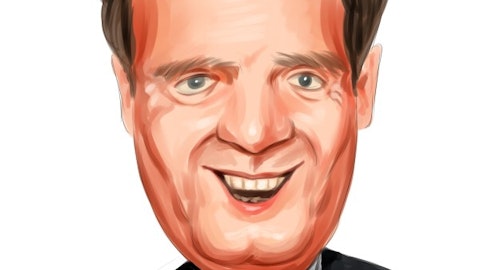Our team does a really good job and continues to refine its ability to target and focus around the prescribers. And we’re always looking to expand the capability set that we have in the surveillance we can provide or the feedback we can give to those prescribing physicians around how patients are responding to the therapy. So we feel good about the position that we have. Again, we fully expect that the chronic is going to grow at a faster pace than the acute, given some of the innovative new products that are entering in. And as I said in my previous comments, we’re certainly looking at new areas of development, whether it’s in the Alzheimer’s space, and in some of the oncology space as there are a significant number of products that are in the pipeline for approval that will require infusion companies to compound dispense and or our nurses to oversee the infusion of the injection to ensure the best clinical outcome.
Jamie Perse: Okay, great. And then one last one. Admittedly, this is the impossible-to-answer question. But John, if you have any [Multiple speakers].
John Rademacher: I’ll give that one to Mike back.
Jamie Perse: Yes, where this is going. But just your perspective on GLP-1, if there’s any categories within your business that you think are have exposure to obese populations and potential for reduction in obesity across the U.S.? Just any early perspective would be helpful. Thank you.
John Rademacher : Yes, Jamie. At this point in time, we don’t see a lot of impact on the products that we dispense or the demand that we’re seeing within the marketplace. Over the longer term, yet to be determined around the long-term benefits of this, but at least under the near or mid-term, we don’t see a significant impact on the products that we dispense or the services that we provide.
Jamie Perse: Okay, great. Thank you.
Operator: Our next question comes from Pito Chickering with Deutsche Bank. Your line is open.
Pito Chickering : Hey, good morning guys. Thanks for tuning me in here. A question is actually on Jamie’s question just there. So looking at the implied fourth quarter revenue guidance, I think you’re saying that you’re facing about 100 basis points impact from ASP pressure. Was it 150, 200 on therapies and 30 to 40 in divestitures? Maybe you said that all those sort of don’t continue into 2024. Does that sort of like the takeaway is about 300 basis points of revenue pressure in the fourth quarter that doesn’t continue into next year?
Mike Shapiro : Yes, I think that’s about right. I think you’re thinking about that right.
Pito Chickering : Perfect. Awesome. And then on the procurement benefit, if you pull out sort of the $9 million for 2Q, $30 million 3Q and $11 million in the fourth quarter, sort of gets to the back half of your EBITDA guidance, excluding procurement of about 9% margins. Okay, is that just the right launch pad to think about for 2024?
Mike Shapiro : Yes. I think as much as we’re celebrating and commending our procurement team for what are real procurement savings, unfortunately. And while that’s us achieve now two quarters of 10% EBITDA margins. Unfortunately, that will subside. And I think you should absolutely adjust the EBITDA margins from a jump-off point perspective, Pito.
Pito Chickering: Thanks so much, guys. Appreciated.
Operator: Our next question comes from Michael Petusky with Barrington Research. Your line is open.
Michael Petusky: Good morning. My GLP question was asked and answered, but let me switch over to M&A. I guess I’m just wondering, obviously, Amedisys deal didn’t go through to completion. Your current thoughts on home health assets and how that potentially could still be a place that makes sense going forward for you guys? Thanks.
John Rademacher : Yes. Michael, it’s John. I think as we tried to convey, the — we really thought the Amedisys was unique in its capability set, certainly with its reach in the star ratings as well as some of its additional capabilities with Contessa and some of the other aspects of that. So not all home health assets are created equal on that. We still believe that there is opportunity for us to play a meaningful role in the home, with the nursing researches that we have and find ways to have better coordination of care for the patients that we serve. I think as we are looking-forward, as we outlined both in my prepared comments, but in our commentary, I think in the near term, we will be looking in the M&A activity closer to the core than expanding broadly into home health through that standpoint.
But there’s an opportunity for us to continue to innovate and to continue to work closely through that process. So we’ll continue to evaluate opportunities that are available. We’ll continue to foster relationships where appropriate. We’re going to continue to look at things both economically and strategically, and make certain that we are ahead of the trends that are happening in the marketplace as the health care ecosystem continues to evolve.
Michael Petusky: All right. Very good, thank you so much.
Operator: And this concludes today’s question-and-answer session. I would like to turn the call back to management for closing.
John Rademacher: Thank you again for joining us this morning and for participating on the call. As we outlined, it was another strong quarter for Option Care Health and our team of passionate care providers. We look forward to continuing to make progress against our key initiatives and providing you updates on our next call. Take care, and have a great day. Thank you, everyone.
Operator: This concludes today’s conference call. Thank you for participating. You may now disconnect.
Follow Option Care Health Inc. (NASDAQ:OPCH)
Follow Option Care Health Inc. (NASDAQ:OPCH)
Receive real-time insider trading and news alerts




